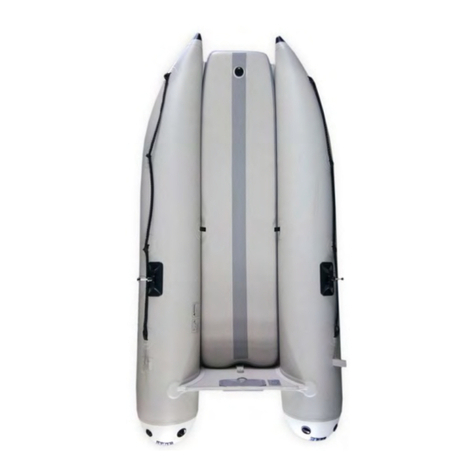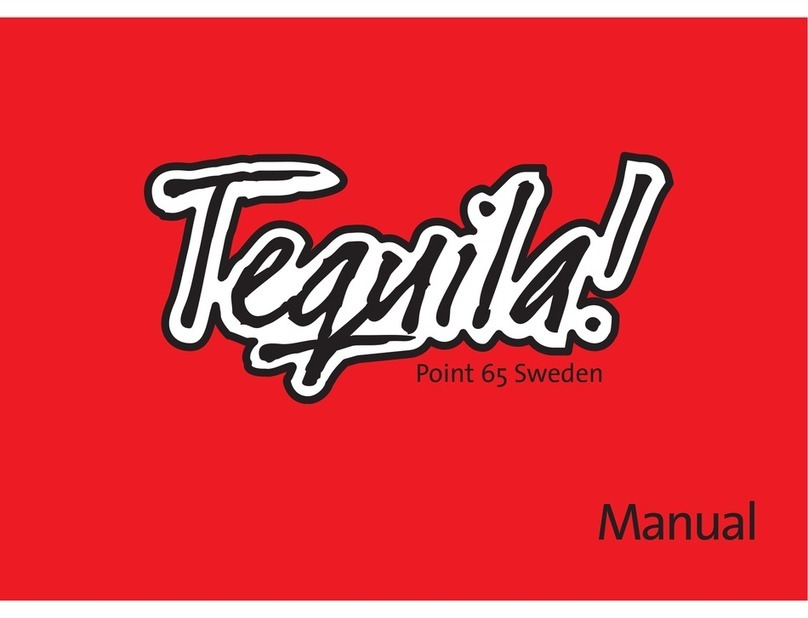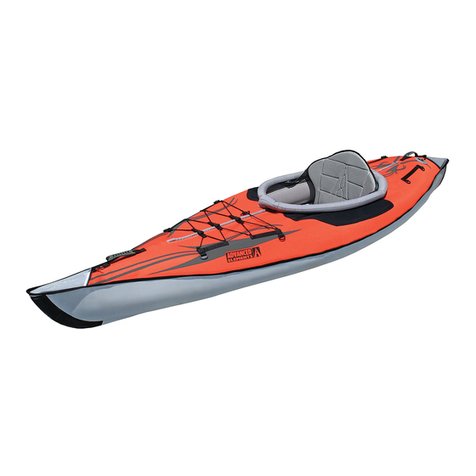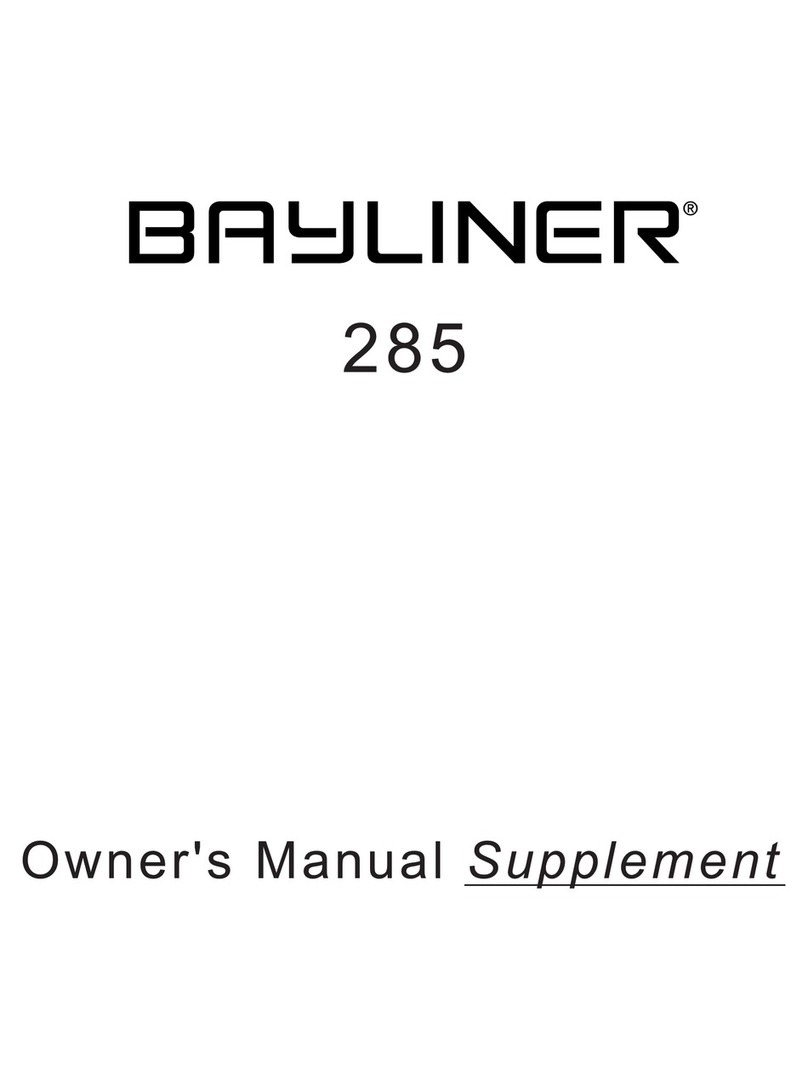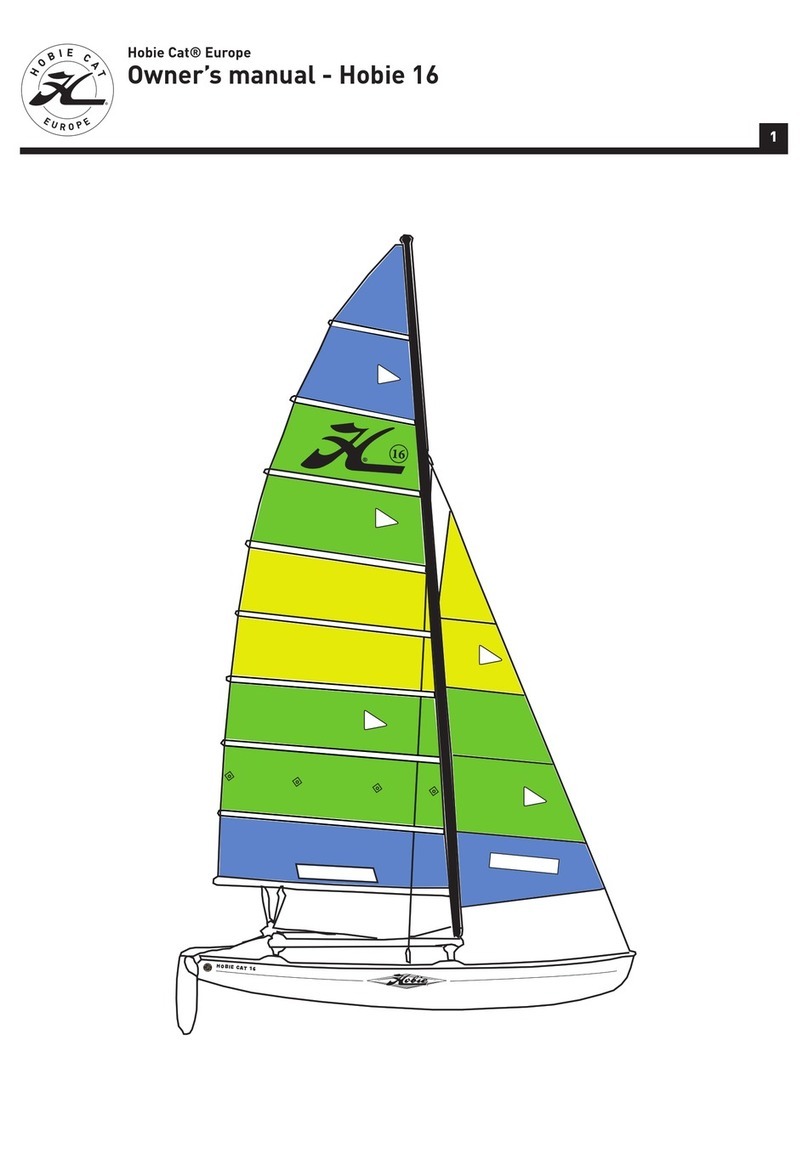Steeler 52S User manual

Owner’s Manual STEELER 52S Performance
Steeler yachts
Wheermaten 16
8331 TL Steenwijk
(The Netherlands)
Version 1.0

Owner’s Manual STEELER 5 2 S performance
page 1
Contents
1. GENERAL .................................................................................................................................................... 5
1.1. INTRODUCTION ...................................................................................................................................... 5
1.2. ABOUT THIS MANUAL............................................................................................................................... 6
1.2.1. Warnings................................................................................................................................... 6
1.2.2. Schematic drawings................................................................................................................... 6
1.2.3. Manuals .................................................................................................................................... 6
1.2.4. Pictures...................................................................................................................................... 7
1.3. NAUTICAL PHRASES AND CONVERSION FACTORS ............................................................................................. 7
2. GENERAL PARTICULARS ............................................................................................................................. 9
2.1. PRODUCER ............................................................................................................................................ 9
2.2. TYPE AND IDENTIFICATION......................................................................................................................... 9
2.2.1. WIN (formerly CIN/ HIN) ............................................................................................................ 9
2.2.2. Builder's plate............................................................................................................................ 9
2.3. DESIGN CATEGORY ................................................................................................................................ 10
2.4. DIMENSIONS,WEIGHTS AND SPECIFICATIONS............................................................................................... 11
2.5. DECK LAYOUT ...................................................................................................................................... 11
2.6. INTERIOR LAYOUT ................................................................................................................................. 12
2.7. ENGINE ROOM,LAZARETTE AND TECHNICAL AREA ......................................................................................... 12
2.8. TANK ARRANGEMENT............................................................................................................................ 13
2.9. PAINT SYSTEM/ANODES ......................................................................................................................... 13
2.9.1. Paint system ............................................................................................................................ 13
2.9.2. Antifouling............................................................................................................................... 13
2.9.3. Anodes .................................................................................................................................... 13
2.10. STABILITY............................................................................................................................................ 14
2.10.1. Maximum load ........................................................................................................................ 14
2.11. SPEED RESTRICTIONS.............................................................................................................................. 15
3. EMERGENCY AND SAFETY (PROCEDURES) ............................................................................................... 16
3.1. WORKING DECK.................................................................................................................................... 16
3.2. EXPLOSION HAZARD............................................................................................................................... 17
3.3. ABANDONING SHIP................................................................................................................................ 17
3.4. LIFESAVING EQUIPMENT ......................................................................................................................... 17
3.5. ESCAPE ROUTES.................................................................................................................................... 18
3.6. FIRE :PRECAUTIONS .............................................................................................................................. 18
3.7. FIREFIGHTING EQUIPMENT ...................................................................................................................... 20
3.7.1. FIRE !! ..................................................................................................................................... 20
3.8. CARBON MONOXIDE .............................................................................................................................. 21
3.9. BATHING PLATFORM.............................................................................................................................. 21
3.10. PERSON OVERBOARD:UNINTENTIONALLY .................................................................................................. 22
3.11. PERSON OVERBOARD:INTENTIONALLY:SWIMMING ...................................................................................... 22
3.12. FLOODING,SWAMPING OR CAPSIZING ....................................................................................................... 22
3.13. COLLISION........................................................................................................................................... 23
3.14. GROUNDING........................................................................................................................................ 23
3.15. LEAKS ................................................................................................................................................ 23
3.16. EMERGENCY STEERING ........................................................................................................................... 23
3.17. TOWING ............................................................................................................................................. 24
3.18. MEDICAL EMERGENCY ........................................................................................................................... 25
3.19. SLIDING WINDOW ................................................................................................................................. 25
3.20. HOOKING POINTS/JACK LINES.................................................................................................................. 25
4. OPENINGS IN HULL, DECK AND SUPERSTRUCTURE.................................................................................. 26

Owner’s Manual STEELER 5 2 S performance
page 2
4.1. THRU-HULL FITTINGS ............................................................................................................................. 26
4.1.1. Hull-penetrating sensor ........................................................................................................... 27
4.2. WINDOWS/HATCHES/DOORS ................................................................................................................. 27
5. DECK EQUIPMENT.................................................................................................................................... 28
5.1. DECK-WASH SYSTEM.............................................................................................................................. 28
5.2. ANCHOR WINCH ................................................................................................................................... 28
5.3. CAPSTANS........................................................................................................................................... 29
5.4. TRANSOM HATCH.................................................................................................................................. 29
5.4.1. Hydraulic tender winch............................................................................................................ 30
5.5. MAST ................................................................................................................................................ 30
5.6. GANGWAY .......................................................................................................................................... 31
5.7. LIFTING ROOF....................................................................................................................................... 32
6. STEERING SYSTEM.................................................................................................................................... 33
6.1. STEERING SYSTEM ................................................................................................................................. 33
6.2. BOW-AND STERN THRUSTER ................................................................................................................... 34
7. PROPULSION............................................................................................................................................ 35
7.1. DIESEL ENGINES.................................................................................................................................... 35
7.1.1. Engine control.......................................................................................................................... 35
7.1.2. Engines cooling........................................................................................................................ 36
7.1.3. Main engines exhaust.............................................................................................................. 37
7.1.4. Propeller and shafting ............................................................................................................. 37
7.2. FUEL SYSTEM ....................................................................................................................................... 37
7.2.1. Filling the fuel tanks................................................................................................................. 38
7.2.2. Diesel filtration ........................................................................................................................ 38
7.2.3. Fuel degrades .......................................................................................................................... 39
7.2.4. Emergency cut-off valves ......................................................................................................... 40
7.2.5. Tank level indicator.................................................................................................................. 40
8. ELECTRICAL SYSTEM................................................................................................................................. 41
8.1. CENTRAL SWITCHBOARD......................................................................................................................... 41
8.2. LAY-OUT OF DC SYSTEM ......................................................................................................................... 41
8.2.1. Charging batteries................................................................................................................... 42
8.2.2. Navigation lights ..................................................................................................................... 43
8.2.3. Hull isolation control................................................................................................................ 43
8.2.4. Fuses DC .................................................................................................................................. 43
8.2.5. Main switches.......................................................................................................................... 43
8.2.6. Tips and advice for DC systems ................................................................................................ 44
8.3. LAY-OUT OF AC SYSTEM ......................................................................................................................... 44
8.3.1. Shore-power ............................................................................................................................ 45
8.3.2. Isolation transformer............................................................................................................... 46
8.3.3. Inverters .................................................................................................................................. 46
8.3.4. Generator................................................................................................................................ 46
8.3.5. Circuit breakers AC .................................................................................................................. 47
8.3.6. Tips and advice for AC systems ................................................................................................ 47
8.4. NAVIGATION EQUIPMENT AND DOMESTIC APPLIANCES................................................................................... 47
9. HYDRAULIC SYSTEMS............................................................................................................................... 48
9.1. CENTRAL HYDRAULIC SYSTEM................................................................................................................... 48
10. WATER- AND WASTE SYSTEMS ................................................................................................................ 49
10.1. FRESH WATER SYSTEM............................................................................................................................ 49
10.1.1. Pressure system....................................................................................................................... 49
10.1.2. Filling the tank......................................................................................................................... 50

Owner’s Manual STEELER 5 2 S performance
page 3
10.1.3. Hot water ................................................................................................................................ 50
10.1.4. Tank level indicator.................................................................................................................. 51
10.2. WASTE WATER SYSTEM .......................................................................................................................... 51
10.2.1. The black water tank ............................................................................................................... 52
10.2.2. The grey water tank................................................................................................................. 52
10.2.3. Heads ...................................................................................................................................... 53
11. TRIM AND STABILIZER SYSTEM ................................................................................................................ 54
11.1. TRIM SYSTEM....................................................................................................................................... 54
11.2. STABILIZING SYSTEM .............................................................................................................................. 54
11.2.1. Stabilizer cooling system.......................................................................................................... 55
12. VENTILATION, AIR CONDITIONING AND HEATING................................................................................... 56
12.1. AIR-CONDITIONING SYSTEM..................................................................................................................... 56
12.1.1. Collection tank......................................................................................................................... 57
12.2. VENTILATION ENGINE ROOM.................................................................................................................... 57
13. BAILING.................................................................................................................................................... 58
13.1. ELECTRICAL BILGE PUMPS........................................................................................................................ 58
13.2. BACKUP BILGE PUMP ............................................................................................................................. 59
14. MAINTENANCE......................................................................................................................................... 60
14.1. THE INTERIOR ...................................................................................................................................... 60
14.2. THE EXTERIOR ...................................................................................................................................... 61
14.2.1. Saltwater corrosion ................................................................................................................. 61
14.2.2. Maintenance of paint .............................................................................................................. 61
14.2.3. Antifouling paint...................................................................................................................... 61
14.3. TECHNICAL SYSTEMS MAINTENANCE/TROUBLE SHOOTING/WINTERIZATION ....................................................... 61
14.3.1. Winterising the ship / laying up: general.................................................................................. 62
14.3.2. Engines and generator............................................................................................................. 62
14.3.3. Engine won't start ................................................................................................................... 62
14.3.4. Steering system ....................................................................................................................... 62
14.3.5. Fuel system.............................................................................................................................. 62
14.3.6. Fresh water system.................................................................................................................. 63
14.3.7. Air-conditioning....................................................................................................................... 63
14.3.8. Wastewater systems ............................................................................................................... 63
14.3.9. Electrical appliance does not work........................................................................................... 63
14.3.10. Battery chargers...................................................................................................................... 64
14.3.11. Bailing system ......................................................................................................................... 64
14.3.12. Fire fighting equipment ........................................................................................................... 65
14.3.13. Thru-hull fittings and seacocks................................................................................................. 65
14.3.14. Thru-hull sensors ..................................................................................................................... 65
14.3.15. Galvanic corrosion ................................................................................................................... 66
14.3.16. Non-return valves .................................................................................................................... 66
14.3.17. Plexiglas: windows, hatches, port lights................................................................................... 66
14.3.18. Stainless steel .......................................................................................................................... 67
14.4. HAULING UP/CRADLING ........................................................................................................................ 67
14.5. CHECKLISTS ......................................................................................................................................... 67
14.5.1. CHECKLIST "DAILY".................................................................................................................. 68
14.5.2. CHECKLIST "PERIODICALLY" .................................................................................................... 69
15. NAVIGATING YOUR SHIP.......................................................................................................................... 75
15.1. STARTING AND STOPPING THE ENGINE........................................................................................................ 75
15.1.1. Manoeuvring........................................................................................................................... 76
15.1.2. Mooring................................................................................................................................... 76
15.1.3. Anchoring................................................................................................................................ 76

Owner’s Manual STEELER 5 2 S performance
page 4
15.2. SPEEDS /RANGE ................................................................................................................................... 77
16. ENVIRONMENTAL CONSIDERATIONS....................................................................................................... 78
16.1. LEAKAGES OF FUEL AND OIL ..................................................................................................................... 78
16.2. HOUSEHOLD WASTE .............................................................................................................................. 78
16.3. CLEANING AGENTS ................................................................................................................................ 78
16.4. NOISE ................................................................................................................................................ 78
16.5. WAVES............................................................................................................................................... 79
16.6. EXHAUST EMISSIONS.............................................................................................................................. 79
16.7. PAINT ................................................................................................................................................ 79
17. RECEIPT OF DOCUMENTS......................................................................................................................... 80
18. DECLARATION OF CONFORMITY.............................................................................................................. 81
19. NOTES ...................................................................................................................................................... 83
20. ANNEXES.................................................................................................................................................. 84
20.1. SUPPLIED MANUALS .............................................................................................................................. 85
20.2. WARRANTY DOCUMENT ......................................................................................................................... 86
20.3. ELECTRICAL DIAGRAMS........................................................................................................................... 87
20.4. SUPPLIED SCHEMATIC DRAWINGS.............................................................................................................. 88
Changes in specifications can be made without due notice.
No rights can be obtained from this manual.
Final responsibility for the contents of this manual lies with the producer of the item which is the subject of this manual.
The producer will not accept responsibility for damages, direct and indirect that result from the literal text of this manual,
when reason and common sense should prevail.
All rights reserved. No part of this manual may be reproduced or transmitted in any form or by any means, electronic or
mechanical, including photocopying, recording or by any information storage or retrieval system, without written permission
from the yard.

Owner’s Manual STEELER 5 2 S performance
page 5
1. General
1.1. Introduction
Congratulations on the purchase of the ‘STEELER 52S’.
This manual has been compiled to help you to operate your craft with safety and pleasure.
It contains details of the craft, the equipment supplied or fitted, its systems and information on its
operation .
Please read it carefully, and familiarise yourself with the craft before using it.
Even when your boat is categorised for them, the sea and wind conditions corresponding to the design
categories1A, B, and C range from strong gale to severe conditions, open to the hazards of a freak
wave or gust, and are therefore dangerous conditions, where only a competent, fit and trained crew
using a well maintained boat can satisfactorily operate in such conditions.
Ensure that the anticipated wind and sea conditions will correspond to the design category of your
boat, and that you and your crew are able to handle the boat in these conditions.
This owner's manual is not a course on boating safety or seamanship. If this is your first craft, or you
are changing to a type of craft you are not familiar with, for your own comfort and safety, please ensure
that you obtain handling and operating experience before "assuming command" of the craft.
Your national sailing federation or yacht club will be pleased to advise you of local sea schools, or
competent instructors.
This owner's manual is not a detailed maintenance or trouble shooting guide. In case of difficulty, refer
to the boat builder or its representative. Always use trained and competent people for maintenance,
fixing or modifications. Modifications that may affect the safety characteristics of the craft shall be
assessed, executed and documented by competent people. The boat builder cannot be held
responsible for modifications he has not approved.
NOTE Any change in the disposition of the masses aboard (for example the addition of a radar, a stowing mast, change
of engine, etc.) may significantly affect the stability, trim and performance of your boat
Users of this boat are advised that :
•all crew should receive suitable training;
•the boat should not carry more than the manufacturer's recommended load;
•bilge water should be kept to a minimum;
•stability is reduced by any weight added high up;
•in rough weather, portholes, windows, hatches, lockers and doorways should be closed to
minimise the risk of flooding;
•stability may be reduced when towing or lifting heavy weights using a davit or boom;
•breaking waves are serious stability hazard.
In some countries a sailing licence or authorisation are required, or specific regulations are in force;
check beforehand.
Always maintain your boat properly and make allowance for the deterioration that will occur in time
and as a result of heavy use or misuse of the boat.
Any boat – no matter how strong it may be, can be severely damaged if not used properly. This is not
compatible with safe boating. Always adjust the speed and direction of the craft to sea conditions.
1Categories are used within the scope of the European Boating Directive

Owner’s Manual STEELER 5 2 S performance
page 9
2. General particulars
2.1. Producer
The ‘STEELER 52S’ is produced by : Steeler Yachts
Address : Wheermaten 16
8331TL Steenwijk
The Netherlands
Phone : +31-(0)521-510268
Internet : www.steeleryachts.com
E-mail : info@steeleryachts.com
2.2. Type and identification
2.2.1. WIN (formerly CIN/ HIN)
The data that are combined into the WIN (Watercraft Identification Number) (formerly known as CIN
or HIN) are amongst others:
•producer
•type of boat
•building month and year
•model year
The WIN is affixed on the upper starboard aft side of the boat (lower step of the staircase to the bathing
platform). The WIN code of your specific yacht can also be found on the “declaration of conformity”
behind §18 of this manual.
CAUTION:
Do not cover, damage or alter the WIN.
2.2.2. Builder's plate
The builder's plate is affixed at the dashboard, well visible from the steering position.
Location WIN
code.

Owner’s Manual STEELER 5 2 S performance
page 10
This plate contains valuable information on the ‘STEELER 52S’, and may not be removed.
The information on this plate contains amongst others:
•name of builder / producer;
•CE-mark;
•design category;
•maximum recommended number of persons when under way;
•maximum recommended load (excl. tank capacities).
WARNING:
•Always put the safety of the crew and the ship on number one.
•Do not exceed the maximum recommended number of persons. Regardless of
the number of persons on board, the total weight of persons and equipment
must never exceed the maximum recommended load.
•Always load the craft carefully and distribute loads appropriately to maintain
design trim (approximately level). Avoid placing heavy weights high up.
•Sea fasten all loose items.
•Adjust your speed and course to the conditions and other traffic.
•Do not make any sudden or unexpected maneuvers to prevent anyone losing
their balance or footing.
2.3. Design category
The design category is assigned to the boat by the producer of the boat.
The ‘STEELER 52S’ is assigned category Abut bear in mind that the speed of the yacht has to be
adjusted to the sea state (see § 2.11).
These categories are defined in the European Boating Directive, and have the following definitions:
A: A recreational craft given design category A is considered to be designed for winds that may
exceed wind force 8 (Beaufort scale) and significant wave height of 4 m and above but
excluding abnormal conditions, such as storm, violent storm, hurricane, tornado and extreme
sea conditions or rogue waves.
B: A recreational craft given design category B is considered to be designed for a wind force up
to, and including, 8 and significant wave height up to, and including, 4 m.
C: A watercraft given design category C is considered to be designed for a wind force up to, and
including, 6 and significant wave height up to, and including, 2 m.
D: A watercraft given design category D is considered to be designed for a wind force up to, and
including, 4 and significant wave height up to, and including, 0,3 m, with occasional waves of
0,5 m maximum height.
Your ‘STEELER 52S’is built to exact standards, and complies with the essential requirements from the
Directive. Herein are laid down the requirements for stability, buoyancy, construction, installations
etc. The ISO standards which are followed to comply with these requirements are listed in the
Declaration of Conformity, refer to § 18.

Owner’s Manual STEELER 5 2 S performance
page 11
2.4. Dimensions, weights and specifications
Building material
Aluminum
remark
Length of the hull (LH)
14.99
m
Length over all
15.68
m
Beam hull
4.70
m
Draught (approx.)
1.2
m
Air draught (approx.)
3.26
m
Mast down, roof down
Air draught (approx.)
3.42
m
Mast down, roof up
Air draught (approx.)
4.3
m
Mast up, roof down
Air draught (approx.)
4.46
m
Mast up, roof up
variations in draught and air draught are approx. 10 cm depending on load and trim
conditions
Displacement (approx.)
18
tonnes
50% loaded
Fresh water (approx.)
750
litres
1 tank
Fuel (approx.)
2.500
litres
2 tanks of 1.250
Black water (approx.)
300
litres
1 tank
Maximum number of persons
6
pers.
on builders plate
Maximum weight
1.060
kg.
on builders plate
Maximum speed (approx.)
knots
to be completed
Engines
2x Cummins QSC 8,3 (447 kW each)
2.5. Deck layout

Owner’s Manual STEELER 5 2 S performance
page 12
2.6. Interior layout
2.7. Engine room, lazarette and technical area
In this manual we frequently talk about the engine room and the technical area. With this we mean:
The technical area can be entered by lifting the staircase from the front of the yacht to the salon. The
engine room can be entered from a hatch in the aft deck.
WARNING:
•The technical area and engine room are high risk areas due to moving parts,
loud noise, high-temperature and electrified parts.
•Keep the technical area’s closed when operating in rough weather and only
enter if absolutely necessary.
•Before entering the high risk areas, make sure you are not wearing clothing that
may cause accidents, such as loose clothing that may get entangled in moving
Engine room.
Technical
area.

Owner’s Manual STEELER 5 2 S performance
page 13
parts. Wear protective clothes suitable for the kind of work (shoes, glasses, ear
muffs and working overalls). Button up cuffs, avoid using ties or scarves and do
not keep long hair loosen.
2.8. Tank arrangement
2.9. Paint system/ anodes
2.9.1. Paint system
A complete two-component paint system has been applied, to achieve a “top class” yacht finish.
Remaining paint must be treated as minor chemical waste. Therefore make sure that during painting
activities this does not end up in the environment.
The paint system may not be polished during the first five years. All polishing agents deteriorate the
structure of the paint such that it will age prematurely.
2.9.2. Antifouling
At delivery, the underwater body has been treated with two layers of anti-fouling paint. The antifouling
has to be repainted every year and should be approved for the specific sailing area.
2.9.3. Anodes
The underwater body of the hull is protected by the “standard” sacrificial anodes. When the yacht is
hauled up, the anodes have to be checked. Replace anodes that are consumed over 50%.
To the inside of pumps and machinery, like the main engines, there could also be anodes. See manuals
() of the equipment for more information on that.
Diesel
approx. 1.250 ltr.
Fresh water
approx. 750 ltr.
Greywater
Buffertank.
Diesel
approx. 1.250 ltr.
Blackwater
approx. 300 ltr.

Owner’s Manual STEELER 5 2 S performance
page 16
3. Emergency and safety (procedures)
Safe boating means knowledge and training about the vessel you are operating and the area in which
you operate. It means knowing the limitations of your yacht, yourself and your crew.
Safe boating means that the Owner / Captain / Operator of your vessel accepts and learns certain basic
rules and practices so that your vessel, you, your crew, your guests, other boaters, and the
environment are protected.
This owner’s manual is not a course on boating safety or seamanship, but in the following section you
will find some information relating to the safe operation of your vessel under normal and adverse
conditions, safety procedures to implement during normal and distress situations, and information
about keeping your environment clean and safe.
WARNING:
•The time to think about emergencies is before they happen. Plan ahead Know
what to do before you encounter any of these situations.
•Wear a PFD when boating.
3.1. Working deck
All persons should wear a suitable buoyancy aid (life jacket/ personal floatation device) when on deck.
Note that in some countries, it is legal requirement to wear a buoyancy aid that complies with their
national regulations at all times.
The bathing platform, decks of the superstructure and front part of fore deck do not belong to the
working deck. The following schematic drawing shows the working area’s:
A. Bathing platform + superstructure area + front part of the fore deck
RESTRICTED AREA while underway. External area without adequate protection against falling
into the sea.
B. Working deck
External area where you are protected against falling into the sea, equipped with a railing,
good handholds and hooking points. Use safety harnesses and lifelines on this area when
conditions require this.
A
A
A
B

Owner’s Manual STEELER 5 2 S performance
page 17
3.2. Explosion hazard
If explosion is imminent, put on PFD's, grab distress signals and survival gear, and immediately abandon
ship.
3.3. Abandoning ship
Please read items below as "if and when possible";
•Make a head count, gather everybody in the cockpit.
•If possible, launch life-raft and (depending on the weather and situation) use this to evacuate the
ship.
•If possible, launch the tender.
•Gather distress signals (if available), personal belongings, telecommunication tools, GPS, EPIRB,
compass (etc.).
•When clear of danger, account (again) for all who were on board, and help those in need.
•Keep everyone together to make rescue easier.
BURN HAZARD – Swim or sail against the current or wind if you abandon ship.
Leaking fuel will float with the current and may ignite.
3.4. Lifesaving equipment
The ‘STEELER 52S’ can be fitted with a life-raft (owner’s delivery). This raft can be stored in the cockpit
area. Have rafts checked annually.
DANGER:
It is the responsibility of the owner / skipper to have sufficient lifesaving equipment
on board for all that sail with you, and to instruct anyone on board of their location,
their use and the relevant procedures for their use.
Refer to the supplied manuals with the equipment.

Owner’s Manual STEELER 5 2 S performance
page 18
3.5. Escape routes
The lower deck of the yacht has two escape routes. One is up the normal stairs to the main deck and
the other one leads through the escape hatch on the front deck (in front of the superstructure).
From the upper deck, the normal entrance door at SB of the wheelhouse is regarded as an emergency
escape door. The door from the salon to the aft deck has to be kept close while at sea and is not
considered an escape door.
WARNING:
•The door from the salon to the aft deck should be kept closed while at sea;
•Never block passages in the accommodation or escape-routes;
•Never block access to safety controls.
3.6. Fire : precautions
We sincerely hope you will never have to use the fire extinguisher on board the ‘STEELER 52S’ but it is
for your safety and for the safety of those on board, that good care is taken of the extinguishers, and
that all the necessary instructions are given to crew and guests.
The extinguishers are fitted in the following locations:
Escape routes.

Owner’s Manual STEELER 5 2 S performance
page 19
WARNING:
NEVER:
•store an extinguisher in the back of a locker, out of easy range;
•leave the ship unattended when cooking appliances are switched on;
•alter systems on board without expert assistance;
•smoke when handling gas, petrol, diesel or other lightly flammable goods;
•store combustible goods in the engine room or technical area (and always sea-
fasten everything).
It is the responsibility of the owner/skipper to:
•have firefighting equipment checked at intervals indicated on the equipment;
•replace firefighting equipment, if expired or discharged, by devices of identical or greater
firefighting capacity;
•inform members of the crew about:
othe location and operation of firefighting equipment;
othe location and operation of the fixed fire extinguisher for the engine compartment;
othe location of escape hatches/ escape routes;
•ensure that the firefighting equipment is readily accessible when the craft is occupied
•keep the bilges clean and check for fuel and gas vapours at regular intervals;
:portable extinguisher
Fixed fire-
extinguisher.
:portable extinguisher

Owner’s Manual STEELER 5 2 S performance
page 20
•when replacing parts of the firefighting equipment only matching components shall be used,
bearing the same designation or being equivalent in their technical and fire resistant capabilities;
•combustible materials shall not be stowed in the engine compartment.
3.7. Firefighting equipment
The ‘STEELER 52S’ is equipped with fire-fighting equipment as follows:
LOCATION
for engine compartment
1 fixed fire extinguisher (automatic and manual
control);
accommodation:
3 pcs, minimum 5A/34B.
CAUTION:
Foam extinguishers may not be exposed to frost. The contents can freeze, possibly
rupturing the cylinder.
The fixed fire extinguisher () for the engine room is automatically and/ or manually operated. The
panel of this extinguisher can be found in the hallway of the lower deck (back of the steering position).
If the fixed extinguishers goes off, an alarm will sound in the wheelhouse and one of the two lights
underneath the steering position will start to flash.
3.7.1. FIRE !!
In case the worst happens and fire starts:
Fire in the accommodation:
•Evacuate the area, make a head count.
•Turn air conditioning, and ventilation systems OFF.
•Delegated task: Inform all aboard of the situation and inform the authorities. Signal for help.
•Delegated task: Prepare for the worst and start emergency procedures for evacuation.
•Delegated task: Put on PFD's, grab distress signals and survival gear, and prepare to abandon ship.
Fire extinguisher
engine room.

Owner’s Manual STEELER 5 2 S performance
page 28
5. Deck equipment
5.1. Deck-wash system
Your yacht is fitted with two dedicated deck-wash connections near the anchor winch (underneath the
PS front hatch.
One of them is supplied by the fresh water system of your yacht (out of the fresh water tank). The
other one is supplied with sea water through a
deck-wash pump. The thru-hull fitting has to be
opened (see § 4.1) and the pump started to get
water pressure on this connection. The pump can
be started from the wheelhouse dashboard.
5.2. Anchor winch
There is an electrically powered anchor winch fitted on the foredeck of the ‘STEELER 52S’. The anchor
winch is fitted underneath the central fore deck hatch. The anchor winch can be controlled from the
dashboard on the wheelhouse. You first have to activate the winch with the left button and then it can
be controlled with the right button. The anchor winch can also be controlled by a wired remote control
from the fore deck.
For more details and maintenance, please refer to the manual of the winch (). Under the section
"Anchoring" (please refer to page 76) you find some general tips and advises on anchoring.
One of the Deck-wash
connection.
Control buttons
anchor winch.

Owner’s Manual STEELER 5 2 S performance
page 31
•Never use the hydraulics under the effects of alcohol, drugs or in conditions of
physical discomfort without being helped.
•Always announce in advance the intention to operate the mast, especially when
there are people on the aft deck.
•Turn the system off when not in use.
•To avoid risk of injury care should be taken to keep hands and limbs clear of
lever and lid pinch zones while operating the mast.
5.6. Gangway
On the PS aft of you yacht, the retractable gangway () has been fitted. This is operated by buttons
on the PS aft deck. The gangway has an own hydraulic powerpack, located in the engine room PS aft
(see picture at § 9.1).
WARNING:
•Never exceed the safe working load of 150 kg.
•Never use the gangway as a springboard. Diving may cause strong strains that
might damage the gangway and its fastening elements.
•The gangway must be used by competent people only. Minors of 16 years or
younger and people who might not be aware of the dangers involved with its
improper use, should not be allowed to use it.
•Always hold children in your arms when boarding over the gangway.
•Operation must always be carried out under visual control and the operation
area must always be well enlightened.
•Never operate the gangway under the effects of alcohol, drugs or in conditions
of physical discomfort without being helped.
•Always keep your balance.
•Always announce in advance the intention to move the gangway, especially
when there are people about to go on it.
•In rough sea conditions or when the stern and the load are swaying, strong and
sudden strains may occur and compromise the stability of the gangway. No
Operation
point gangway.
Table of contents
Popular Boat manuals by other brands

Bruckmann Yachts
Bruckmann Yachts X Dimension user manual

Horizon Yacht Charters
Horizon Yacht Charters FP Lucia 40 2020 Information & operation manual

Regal
Regal 2000 owner's manual

Yamaha
Yamaha HT-140980 quick start guide

Premier
Premier Landmark43 2009 owner's manual

Pro-Line Boats
Pro-Line Boats 23 Walk owner's manual
